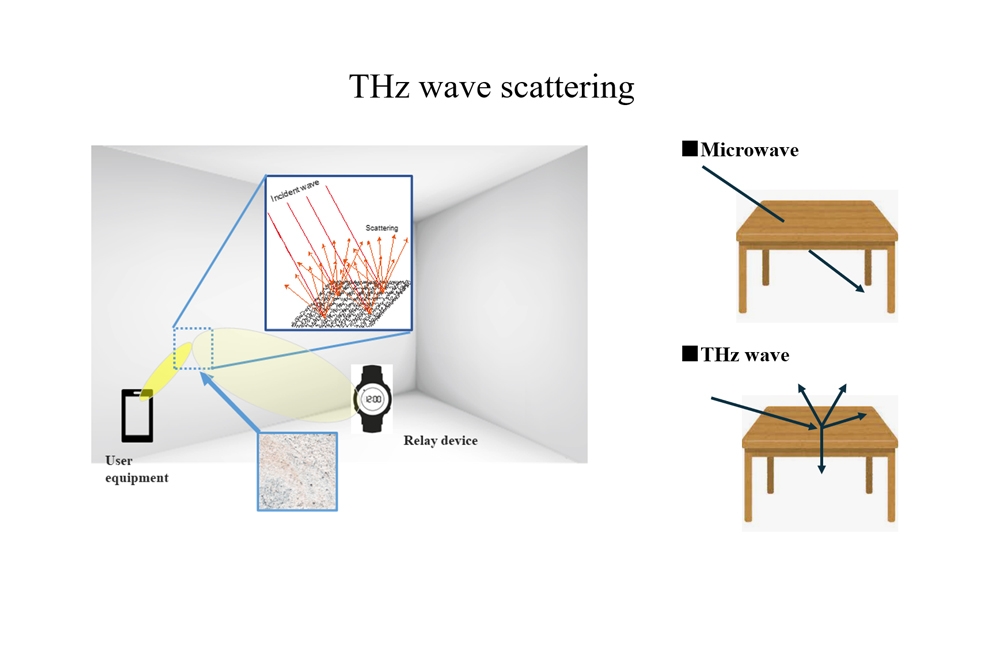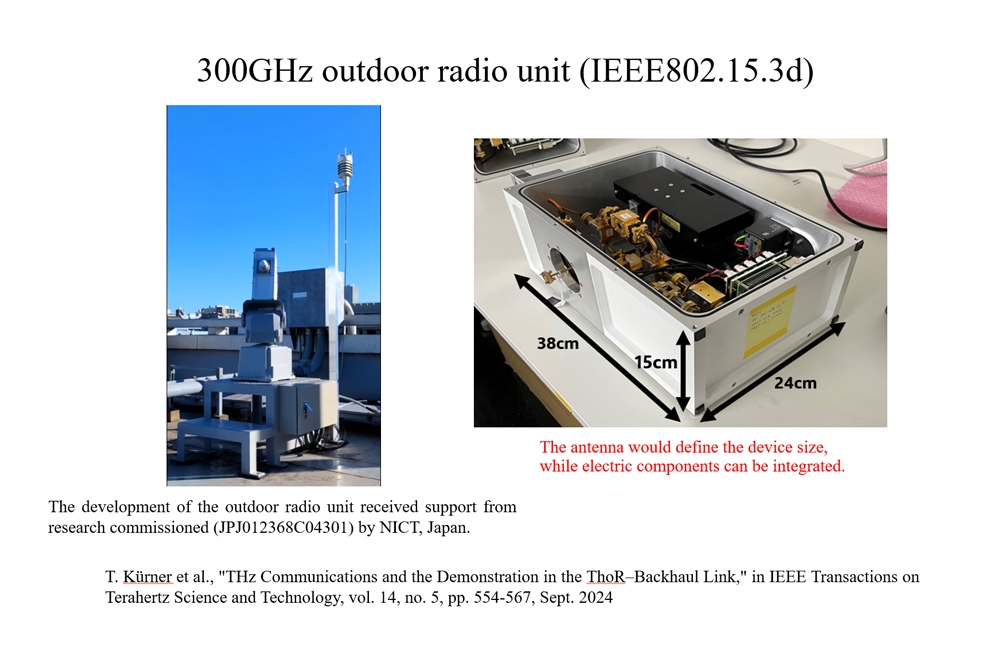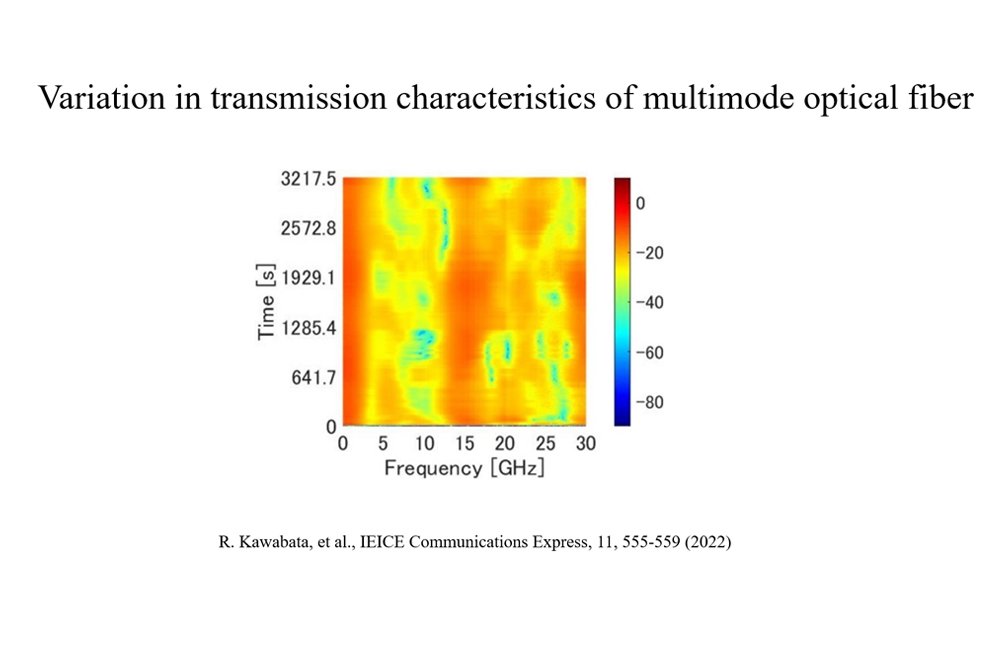Language : EN / JP
Language : EN / JP

Research Contents
In conventional optical fiber and wireless communications, devices and systems have been designed to optimize electromagnetism,
specifically light waves and radio waves described by Maxwell's equations. However, next-generation networks will require the efficient use of various transmission media in diverse environments,
including the emerging use of terahertz waves. While these waves are anticipated to enable high-capacity data transmission due to their high frequencies,
their short wavelengths may be affected by mechanical vibrations. Optimizing their performance will require a multiphysics approach,
incorporating perspectives from electromagnetics and mechanical and environmental engineering.
In this study, researchers from Japan, Germany, and France are investigating terahertz waves as a crucial new transmission medium,
integrating them with optical networks to develop communications with superior environmental resistance.
The Japanese team will focus on propagation analysis, antenna measurement, environmentally resistant optical communications, and electromagnetic and mechanical multiphysics analysis.
Meanwhile, the German and French teams will handle radio wave propagation, system integration simulation, examining use cases, and terahertz device development.
We aim to promote knowledge sharing and build highly competitive international teams through workshops and joint experiments.
Our objective is to academically and theoretically demonstrate the performance of globally installed networks and establish design guidelines for optimizing the performance of actual networks.
To cover interdisciplinary fields, we have set three research topics:
① development of elemental technologies for terahertz communication,
② multiphysics analysis of terahertz wave antennas, and
③ optical fiber communication for use in harsh environments.
We will develop a shared experimental environment like a terahertz wireless testbed to strengthen international collaborative research
and promote exchanges among young researchers. Furthermore, we aim to deepen collaboration by working closely together.
The three research projects will be integrated, with no separation of tasks, ensuring a cohesive effort.

Under this theme, we will research terahertz wave technologies using photonics to overcome the three main challenges facing terahertz waves: gaps in electromagnetic wave generation technologies,
processing technology, and gaps in propagation. We aim to develop practical technologies combining cutting-edge science such as terahertz physics and high-speed photonics,
analyze terahertz wave propagation in real environments, utilize terahertz communication through dielectric media, and conduct use case studies.
We also aim to establish a research system that organically connects to international standardization.
We are exploring methods to convert signals generated using photonics (light bandwidths) into terahertz waves or to create highly stable transmission systems using light
and terahertz waves simultaneously.
We can expect significant advancements by forming a team that effectively combines growing needs with accumulated elemental technologies.
We will address how far communication capacity can be increased globally, considering the physics of signal generation and detection, climate change,
other environmental factors, and resource-related issues. Additionally, we will explore use cases and the societal role of information communication technology to determine the necessary extent of
increased communication capacity.
Within this team, the Japanese team will focus primarily on propagation analysis and integration with photonics.
The German and French teams will handle integration simulations, examining use cases, and terahertz device development.

Under this theme, we will focus on antennas essential for terahertz communication and concentrate on their evaluation and design technologies.
The microwave band antennas previously used in wireless communications were considered stationary or fixed installations,
which sufficed for evaluations focused solely on pure electromagnetic properties. However, in terahertz wave bands above 100 GHz,
the wavelengths are significantly shorter than those of microwave bands, resulting in increased directionality.
Therefore, the mechanical deflection of antennas due to a narrow beam divergence angle cannot be ignored,
necessitating a comprehensive evaluation that includes the mechanical deflection of the structure (mechanical vibration, position shifts due to wind or heat,
twisting of the antenna aperture, etc.). In other words, a multiphysics perspective is essential.
Under this theme, we aim to establish a comprehensive antenna evaluation method from a multiphysics perspective that considers mechanical properties,
thermal and mechanical disturbances, and electromagnetic properties. High-gain antennas in the terahertz wave band have physical dimensions large compared to the wavelength,
making electromagnetic simulations resource-intensive. Consequently, time and cost are significant issues for studying multiphysics problems solely through simulations.
This research team possesses the technology to measure the phase distribution of terahertz waves with a high-gain antenna aperture,
allowing us to approach multiphysics problems by integrating experiments with simulations and model calculations.
The Japanese team will primarily be responsible for antenna and multiphysics analyses, while the German team will focus on simulation software development and measurement of properties.

Under this theme, we will research movable optical communication systems for use in environments with challenging temperature,
humidity, or vibration conditions, such as automotive or industrial applications.
As research and implementation of non-terrestrial network technologies aimed at Beyond 5G/6G progress, networking between different platforms such as drones,
high-altitude platforms (HAPS), and non-geostationary satellites is also advancing, creating a need for high-speed, high-capacity networks in every location.
However, these environments, like those in automotive and industrial applications, demand stable operation under harsh conditions.
For example, next-generation vehicle optical fiber communication relies on multimode optical fiber,
which has a large core diameter and is resistant to axis misalignment due to vibrations and temperature changes. Multiphysics studies, including those on vibrations,
temperature, and radiation, are essential for achieving stable high-capacity communication in extreme environments.
By promoting joint numerical and experimental studies that create simulated and hybrid (emulated) environments using experimental results,
we aim to foster effective collaboration across traditionally separate fields and open up new interdisciplinary areas.
This team will be led by the Japanese side,
with the German side cooperating in examining use cases. Although cooperation between the Japanese and German automotive industries in this field has been limited so far,
we aim to enhance collaboration by promoting research centered on Japanese and German research institutions, serving as an interface for cooperation between the automotive industries of both countries.
